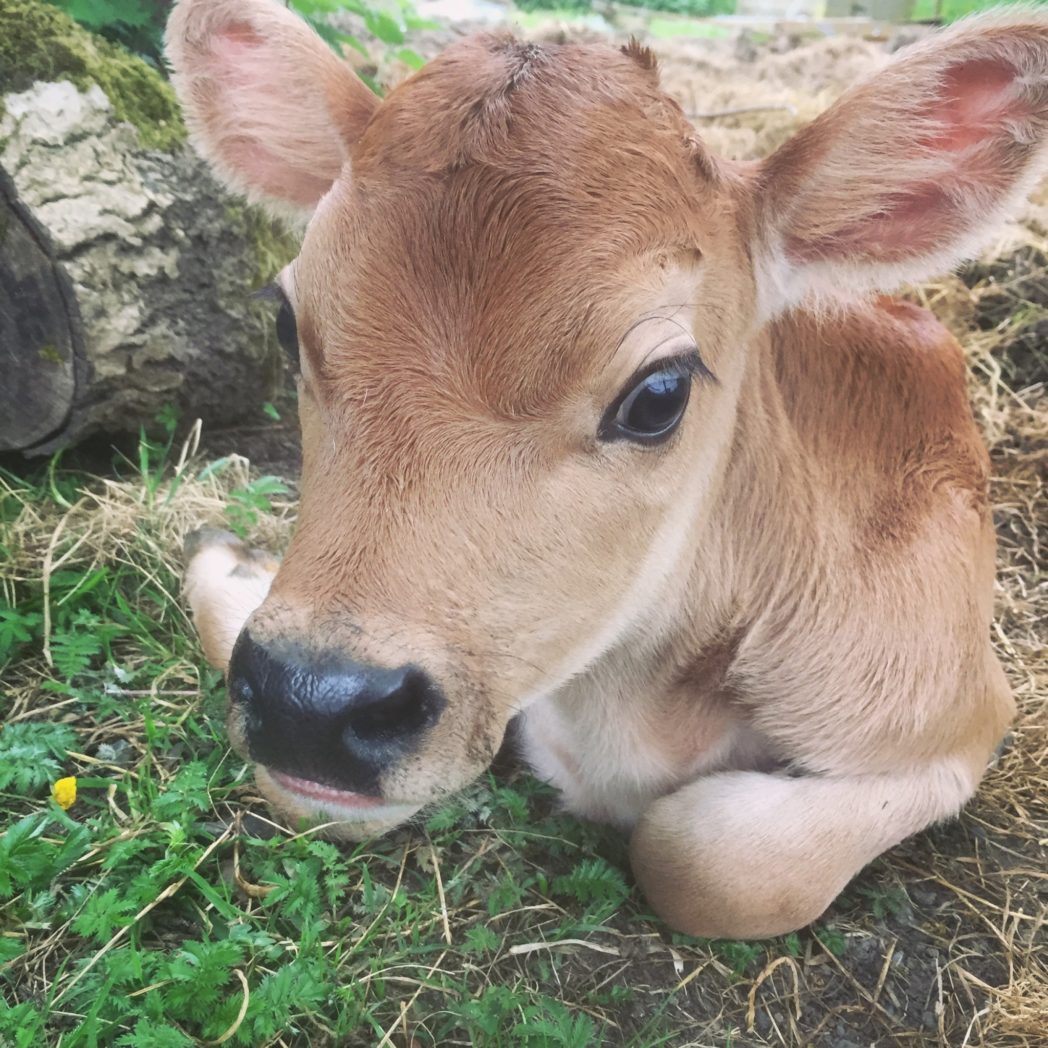Sitting outside with the sun beating down, the trees in full leaf, berries bursting from fruit bushes, grass finally in full vigour, hedgerows in full flower, and the earth dry and dusty it’s hard to remember the knee-deep mud and long, dark nights of winter. In the last month we’ve had around 10mm of rain, and days have mostly been in the mid 20s, with a couple even hitting 30 degrees. The eternal early summer of late spring has been welcome. How quickly we forget what’s been.
For the most part winter was a welcome respite for us, allowing us to spend time in front of the fire reflecting and recuperating; although we didn’t feel as rested coming out of this winter as we did last year and felt like we needed a bit more time doing less. I wouldn’t say that the cold and snow hit us hard like it did many farms. Our cows were safely tucked up in the barn, and whilst we did have a week without running water outside, which meant carrying nearly a ton of water by bucket from the house each day, we didn’t really suffer that badly, though my shoulders perhaps did!
As I’ve already written, last year was full of highs and lows, and we’re hoping that this year will be more steady. This will be our third season here too, and now that we’ve had time to settle in and observe the land we inhabit, we now have a greater and growing sense of our plans for the farm. Various parts of the jigsaw are falling into place.
To begin with however we had a challenging start to the year, with the passing of one of our beloved milking cows Blossom, who sadly injured her foot and never recovered. She went down overnight, for reasons we’re not 100% sure of, but we think, as she was bulling, that one of the other cows had likely jumped on her and injured her ankle. She couldn’t bear any wait on her front left foot, despite our best efforts which included trying every conventional and alternative medicine and treatment we could. We spent a difficult week caring for her; hand-feeding her, drenching her (‘forcing’ her to drink), injecting her, moving her, turning her over and lifting her up with the tractor (to get circulation going and persuade her to get up). We spent every minute we could nursing her, hoping her ankle would heal in time for her to get back up. Sadly, when a cow goes down and stays down, the odds are against you, and after about 5 days we struggled to get her to eat enough hay, and her ankle still wasn’t yet healed. We went out one morning to find she’d passed away overnight. This was real blow, and we had to struggle not to see it as an omen for the year ahead. The grief of 2017, was met with grief in the first week of 2018.
We’d both already held her in our arms and cried with her and said our goodbyes. She was a beautiful soul; gentle, nurturing, easy-going and doted on her bull calf Sven. We still miss her now. It’s easy to mutter a plaintive like, “it’s farming”, and it is, that’s true. But it hurts to lose an animal. They’re a living being that we’re grateful to share existence with.
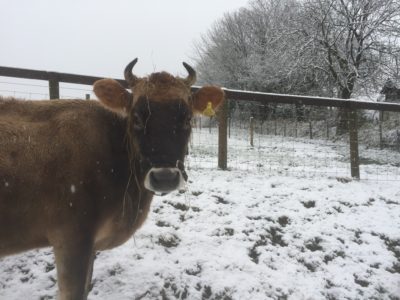
It took us the rest of January to recover from our emotional and physical exhaustion, as we were already tired from a hectic Christmas period of beef butchery and delivery. The continuous drizzle and cold weather didn’t help either, but like the snow drops and daffodils that dared to show their delicate, petalled faces, we too felt the unfurling of spring with the gradually-building subtle warmth of the occasional sunny day. We were drawn back outside again from our hiding place and back into the world of action, as winter once more passed.
We were excited to get the cows back out on grass in early April, though we struggled with very slow grass growth until a brief period in the middle of May when growth kicked-on, only for it to die down again with this prolonged dry spell. A farmer is never happy with the weather, I’ve learnt. This time last year the grass was knee-height, and this year we’re lucky if it’s past our ankles. That’s meant we’ve grazed it harder than we’d like, but now that’s it finally growing, and we’ve taken on some extra summer grazing, we can give the grass a chance to recover and grow ahead.
At the beginning of May we took on 14 acres of summer grazing for our beef herd. Ideally it’s just 500 yards down the track at our neighbour’s farm, meaning we can go down once a day to check on them and move them to fresh grass. In the short walk I must pass more than 40 varieties of trees and plants, all providing habitat for wildlife. Corridors of biodiversity that are essential to our ecosystems. Along with our growing beef herd?—?with cows, steers and calves soon to number more than 20 cattle?—?we’ve taken all of our dry and suckling dairy cows and calves down there to free up grazing on our land for the half dozen milking cows.
The biggest development over the last few months has been the arrival of several more cows! Our dairy herd, including calves, has grown to 15 with the arrival of Ceri, Belle, Coch Mawr, Lizzie and calves Fairy, Patrick and Toro. We’d been looking for some new cows, and a post came up on a forum we’re members of, advertising a small dairy farm that was selling up their herd. We travelled promptly to Leicester to go see them, meeting Alan and Jane Hewson, a lovely couple that have farmed for decades and now want to wind down the dairy side of things. They run a thriving dairy selling raw milk producing their own award-winning raw milk cheese. We were very fortunate to have the pick of their cows.
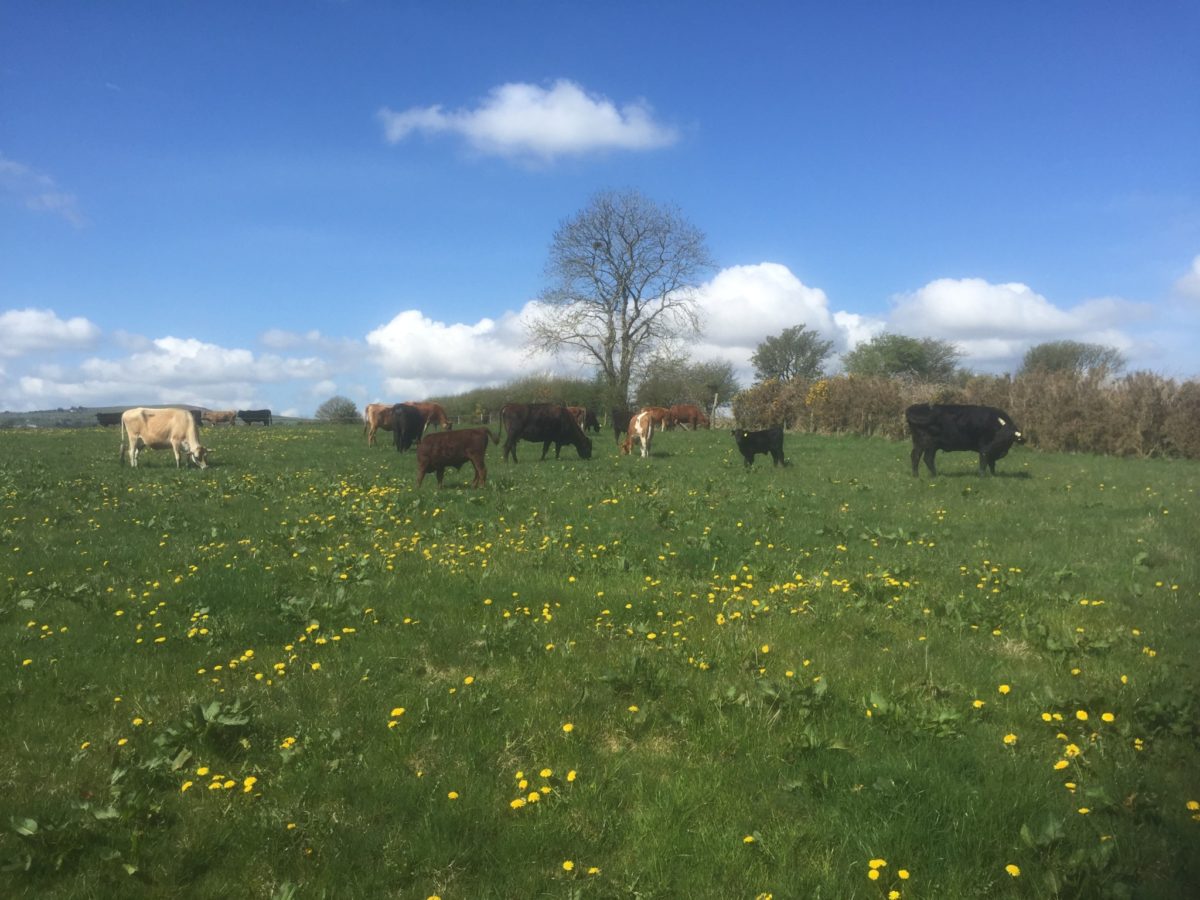
It means we are no longer purely Jersey milk, as Ceri is a Kerry cow, a rare, ancient Irish breed with majestic horns, Coch Mawr is a pure Red Poll, another rare breed that originates from Norfolk/Suffolk, and Belle and Lizzie are a a mix of Jersey, Frisian, and Red Poll. I’m quite excited to see how each breed differs, and from there we can look to develop our own herd which is suited to our own context. I love the flavour of Jersey milk, but I’m interested to see if we can tailor our breeding to something that suits us best, in particular we could do with bull calves that have more muscle on them. Our Jersey bull calves from last year, including the Jersey Angus cross, are very small. Whereas our red poll bull from Belle is already chunky and bull-like at just 5 months of age. We currently have five in milk, and of that only three are we milking, Nelly, Luna and Coch, as Ceri’s calf is now 3 months and is on his mother 24/7, and Belle’s calf Toro, a vivacious, excitable bull calf is now nearly 6 months of age and suckling 24/7, and will shortly be weaned.
That’s a change for us as last year we separated the calves at night, so that we could take some milk first in the morning, but we found it quite stressful and tiring. The mother and calf would both be bawling, and separating calves in a field at 9pm was never much fun?—?they have a sidestep that puts rugby player Shane Williams to shame. Combine that with issues with let-down (giving us their milk), and often just for 1.5L of milk, we didn’t feel it was worth carrying on like that this year, so we’re trying a different approach with advice from Alan, the previous owner of our new cows, who also ran a system where the calves suckle their mother until around 6 months of age.
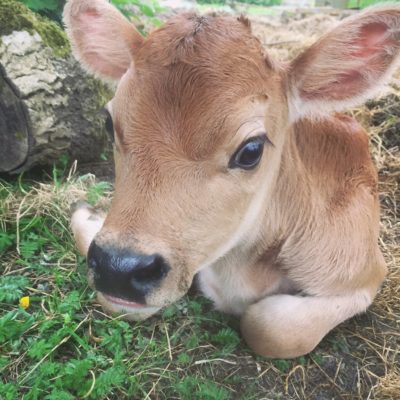
It does mean there’s a period of about 2–3 months where we don’t get any milk from the cow, but we’ve changed our system to accommodate that going forward by having some extra cows and only planning to calve them every 18 months or so. It makes our style of dairying a hybrid of a beef suckler herd and a dairy herd which we think will work well for us, seeing as we also sell beef direct. Time will tell of course. Our aim is to be milking around 10-12 cows at ay one time, though we might have closer to 20 in the herd. We’re looking at investing in an upgrade to our milking machinery and equipping something like cable carriers to keep everything tidy and protected – browse cable carriers.
We’ve just had the first cow to calve here for the second time, Ruby giving birth to a gorgeous little heifer calf, Olwen. She calved outside, unassisted and it seems without drama. She’s an absolute mini version of Ruby. Spitting image of her. And she loves to hide in long grass, and hedgerows, leaving us to spend hours looking for her.
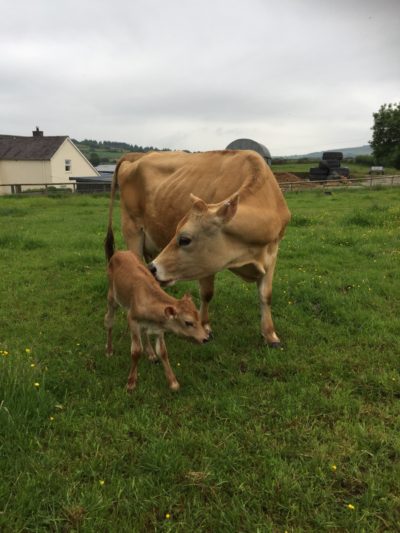
The rapid growth of the farm over the last 6 months means that we’ve often stuggled to find enough time off farm-work for ourselves and each other. Dairying is a relentless task at times, as you have to do it every single morning, whether you feel like it or not. And sometimes we don’t feel like it. Sometimes we want to have a lie-in, or do something else with the morning. But dairying doesn’t allow that. In the two years we’ve been here, Sam and I have had less than five whole days off the farm together, and we’ve each had less than 10 full days off work individually. When you consider that the average person would’ve had more than 200 full days off work in that time, it puts in perspective the discipline demanded by farming.
Since the beginning of April we’ve worked 70 hour weeks, or more, every single week, in order to get everything ready for the expansion we’ve gone under. That takes its toll. And the hours itself don’t really tell the full story. It’s the constant decision making, time pressure, juggling of several demands at once and other mental stresses that add up. In any one day we might need to call suppliers, work on financial spreadsheets, milk cows, bottle milk, move cattle, answer customers, muck out the barn and lay out new water piping. And all that will be done by lunch-time, leaving the afternoon to get on with some sort of infrastructure building or maintenance. I love the diversity of working as a farmer, I need that as I get bored doing the same thing all the time, but it can be stressful trying to handle so much at once. It doesn’t leave a lot of space in my head for myself.
(I must quickly note here friends like Lauren and Phil who came to spend a very long day finishing the dairy parlour with us in time for the new arrivals.)
We know long-term that isn’t sustainable for us. And we recently hit a bit of a wall with exhaustion and burn-out seeping in. We resisted for a while, trying hard to hold it all together, to resist the inevitable entropic processes of life. We don’t want to live our lives teetering on the edge of burn-out with cortisol continually surging through our veins. We can try so hard to hold it all together, that in the end we don’t break, but get annihilated. I’ve learnt that sometimes we must stop resisting and persisting, and learn to re-build and re-shape. It’s so often our rigid ideas and beliefs that get in the way, rather than the situation itself. I think we have to catch ourselves when we say things like, ‘never,’ or ‘always’?—?perhaps there’s a different way, an exception? Do we have to milk every single day? Why aren’t we allowed a day off? Why aren’t we allowed a holiday?
I know many farmers work harder than this, but I’ve also seen the toll this takes on them. I’ve recently seen people break-up, break-down and burn-out, and we don’t want to join them. There’s a reason why depression and suicide stalk farming. Financial pressure and exhaustion are a toxic mix and yet one drives the other. Most businesses fail in the first few years, and when you consider how difficult it is to start a farm from scratch, and make farming profitable, then you realise how it’s a nearly impossible task.
So fear of failure drives over-working, which leads to burn-out and eventual failure. It’s a tricky loop not to fall into, and despite our best efforts it can claim us. So somehow we’ve got to find that elusive balance within all this before we too are claimed.
We have an amazing friend Jacqui who relief milks for us two mornings a week, and another friend is about to join us too to provide extra cover and the opportunity for time away. The difficulty over the last couple of months is that with new cows arriving, a new dairy parlour, and heifers calving, we’ve needed two people milking for a while, to make it manageable. And with so much to do, any time off milking means meeting other demands. I think we’re now over that hill and can return to some sort of weekly balance.
The key we’ve realised for ourselves, is that we need a community of people and we need to let go, or perhaps rather I need to let go. I’m sure one of the driving causes of burn-out, depression and suicide within farming is the isolation and loneliness. Not only do you spend a lot of time alone, but you spend a lot of time on your own struggling with the pressure of it all. You’re often trying to be in three places at once. I think back to the farms of the early 1900s and beyond, and whilst they didn’t have the luxury of plastic water piping, tractors and quads, they did have the luxury of people. Farms were busier, with more people working on the land. Today one person can farm thousands of acres, and often that’s the only economical way of doing so within our current economic system.
Given that we’re not trying to produce for the commodity market, it gives us the opportunity to bring in more people. We may only be currently managing 29 acres, but I think we can find employment for a couple of extra people, or better yet a sort of profit share system. I think the resiliency most farms are lacking, is due to the lack of people. Thinking we can, and have to do it all is tiring and stressful and often not true. Often it’s our own desire for control and lack of trust in others that needs to be overcome, and with a little bit of creativity we’re finding ways of bringing more people into the farm to help us and support us and hopefully we can reciprocate.
With that in mind we’ve decided that next year we’re going to dry all the dairy cows off together at the same time, so that we can have about 6 weeks off milking, and in that time are planning a two week holiday. It’s something we would like to do every couple of years, to give us that much needed respite.
But before then, in a couple weeks, we’ll be off for a few days, leaving the cows in Jacqui’s very capable hands, and the rest of the farm in Sam’s parents equally capable hands, so that we can spend 3 nights away for our first wedding anniversary. We haven’t found that balance yet, but hopefully, by struggling with it, we can find it. To find that balance it’s meant growing the farm, to provide extra income, to support other people. In the short term that’s meant more pressure but hopefully long-term it leads to better balance.
The trick with burn-out is to use it as an opportinuty to re-assess. To think about what led us to that place, and what we can do differently in future. To not just cope better but to use that burn-out as a chance for improvement. With creativity, reflection and questioning I think we can just about find that elusive farm-life balance.
“The world breaks everyone, and afterward many are strong at the broken places. But those that will not break – it kills.” Ernest Hemingway



